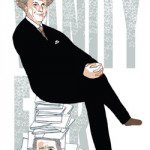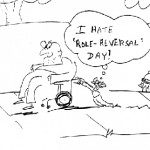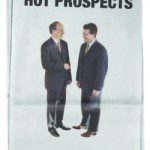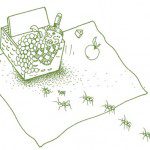Dynamic Duel
Vancouver Sun editor Patricia Graham and Tyee editor David Beers are "oil and water." They fight, they feud and, through the heat of competition, they've improved the city's news culture
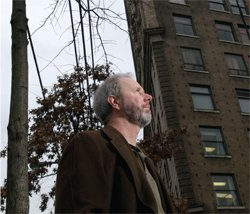
The floor-to-ceiling windows in the editor-in-chief’s office at The Vancouver Sun face northeast, beyond the white sails of the city’s convention centre to the North Shore Mountains. In early spring 2000, then editor-in-chief John Cruickshank stared out the windows while his two to p editors argued. A simmering power struggle between managing editor Patricia Graham and chief features editor David Beers was coming to a boil. The wrangling had started soon after Beers’s arrival at the paper two years earlier, but they’d both climbed a rung on the management ladder before the end of 1999, so now the stakes were higher.
Graham, groomed from within since the mid-1980s, is five-foot-four and rail-thin. She speaks slowly and projects total confidence and an engaging frankness. Her manner is cool, and it’s difficult to imagine her measured voice rising. Beers, originally from San Francisco, stands nearly a foot taller, lean and lanky, with a receding patch of grey leading into a neatly trimmed beard. He is soft-spoken, but quietly fierce with his words and opinions.
Cruickshank felt that as long as he was there to steady the focus, the tension of having “David operating in one channel” and “Patricia in another” would work, despite the “oil and water going on between the two.” But the merging of two distinct talents into one creative force hadn’t occurred. Beers claimed he’d been granted special “powers to effect creative change at the Sun.” Graham thought he’d “misread many things.” And Cruickshank, an intellectual type who came from The Globe and Mail in 1996, was determined to make his mark on the paper. He’d formed a creative trio – himself, Beers and chief designer Jim Emerson (although he says they “frequently engaged Patricia”) – to give the paper “a brighter, more sophisticated look.”
In a 2002 Vancouvermagazine piece, Beers wrote that the “exchange was ugly” in Cruickshank’s office. He and Graham “found themselves sweating and sometimes swearing” during the meeting. And Graham, looking back now, says the encounter was “bizarre. I kept saying, ‘I feel like I’m in a therapy session,’ when we were in there.”
Not long after the tense encounter, Cruickshank made a surprise announcement – he was to become co-editor and vice-president editorial at the Sun-Times in Chicago. When he left, the fragile détente went with him, but the discord had charged the atmosphere and the paper thrived during the turmoil. “Papers are often most vital when there is conflict inside them,” he says now. “When it’s Happy Valley at a newspaper, the paper is never as stimulating.”
Fresh from overhauling the Ottawa Citizen, Cruickshank’s successor Neil Reynolds found himself saddled with two bickering senior editors. His immediate solution was to create the unique position, at least for a newspaper, of essayist, which relieved the pressure by keeping Beers outside the management structure. Eleven months later, Beers was out of a job. “I was fired,” he says. “In fact, I forced them to tick the box on the form that said fired because they were firing me.” Reynolds, now a columnist for the Globe, thought Beers was a brilliant editor, but says he offended senior management with public criticisms of the paper. And Beers’s reaction to dismissal puzzled him. “Newspapers are a pretty turbulent business,” Reynolds says. “I’ve never known anyone in my life to get so upset about one job change.”
In the seven years since that sweaty, expletiveflecked meeting, Graham and Beers have remained at the heart of Vancouver’s news scene, symbols of the clash between corporate and independent media. Graham is a dedicated newswoman and the Sun is not entirely the corporate nightmare some say it is. Beers is an independent-minded editor who gets more attention for his website than its size and age warrant. The two are engaged in a media symbiosis – the little website with the big name spawned in reaction to the big newspaper with little web savvy – where each prods the other to progress. But everyone agrees on one thing: the more the competition can push the corporate Goliath, the better.
Vancouver is a multicultural centre feverishly preparing to host the 2010 winter Olympics. It is a proudly diverse city, with nearly half its population born outside Canada. Yet its media ownership is among the most homogeneous in the world. The Sun falls under the umbrella of CanWest Global Communications Corp., which also owns the National Post; The Province, the only other major metropolitan daily in the city; Victoria’s Times-Colonist, the major daily in the province’s capital; two other dailies on Vancouver Island; 20community weeklies in the province; and co-owns the Vancouver edition of Metro, the free commuter daily. It also owns Global Television, which hosts the most watched evening newscast in the city, and the CH network, which broadcasts in Victoria.
This reduction of news proprietors didn’t develop overnight. The Sun has been around since 1912, when the city’s population was just over 100,000. It sprung up in a market already dominated by the Province, which has been publishing since 1898, and owned by Southam since the 1920s. The two competed head to head until a massive labour strike at the Province in the 1940s gave the Sun the edge in circulation. Don Cromie realized Southam’s financial resources would eventually swamp his family-owned Sun, so in 1957 the two papers formed a new publishing partnership called Pacific Press. Although housed and printed together, they remained under separate ownership. Six years later, Cromie sold to FP Publications, an inconspicuous first step toward Vancouver’s concentrated media ownership. The FP-Southam arrangement lasted until 1980, when strikes and labour problems forced Sun owners to sell to the former Thomson Corp. chain. Thomson turned around less than a year later and sold the Sun to Southam, giving it ownership of both major dailies. Then, throughout the 1990s, Hollinger gradually acquired full ownership of Southam until finally, in 2000CanWest bought most of the Hollinger papers.
The elimination of competition didn’t go unnoticed by the Canadian government. Between 1969 and 1980, the Davey Committee, the Kent Report and the Bryce Commission all found ownership concentration excessive, but their reports were shelved. More recently, “outright market domination in certain Canadian media markets” was addressed in the Standing Senate Committee on Transport and Communications’s Final Report on the Canadian News Media, released June 2006. Representatives from CanWest, as well as an online upstart called The Tyee, founded by Beers, were among the 304 witnesses who testified.
Some journalists have grumbled about the Sun’s corporate bias and lack of diverse local coverage, even as it employs talented journalists, breaks stories and wins awards. Online innovations have made local information easier to come by, but web-based independent journalism is not yet the norm. One notable exception is the Tyee, which has elbowed its way into the public discourse in less than four years. The Sun, despite decidedly higher numbers of unique hits, has not been innovative in this area. It touts contests – win a condominium, find the worst song ever – and concert reviewers who stay for the show’s encore as local online initiatives, which only fuels criticism about the lack of serious coverage in the public interest. The Senate committee, for its part, recommended that media mergers be subject to a new section of the Canadian Competition Act, but the federal government has not acted on the report.
Today, the Sun and the Province share prime waterfront real estate. The dull brown block at 200 Granville Street is sandwiched between the railway station and gaming giant Electronic Arts. Kirk LaPointe, the Sun’s managing editor, insists the Province is a fierce competitor, dismissing the fact that they share a publisher, are in the same building and are owned by the same company. “We have very different approaches to news,” he says, “very different operating standards.” While both have seen declines in circulation in recent years, the Sun remains ahead in paid daily circulation, with a weekday average of 162,835 compared to the Province’s 141,506.
Trying to keep it that way is the Sun’s current editor-in-chief, Graham, who grew up in west Toronto and graduated from Osgoode Hall Law School in 1974. She didn’t care much for practicing law and landed a summer reporting job at the Globe by impressing then editor Dic Doyle with her only writing samples – short stories she’d never shown a soul. After a year at the paper, she moved on, eventually landing on Quadra Island, one of the Gulf Islands nestled between mainland B.C. and Vancouver Island. In the community known for its sport fishing and arts-and-crafts lifestyle, she took another journalism summer gig, this time writing for Campbell River’s Courier-Upper Islander (now the Courier-Islander). Leaving island life behind in 1986, she moved through the ranks at the Province – copy editor, editorial writer, weekly columnist, editorial page editor. After five years in Vancouver, she jumped to the senior editor slot at the Sun, a position for which she didn’t feel ready. Snatching the editorial page position at first opportunity, she honed her skills on the opinion pages. By 1997, Cruickshank wanted her “maturity of judgment” in the newsroom and convinced her to become senior editor in charge of news. “I promised her that if she plunged in and did a good job,” says Cruickshank, now publisher of the Sun-Times and chief operating officer of the Sun-Times News Group, “she’d have an opportunity to take on a paper someday.”
That day came in 2003, when Graham took the helm at age 54. Unlike her previous Sun editors, she’d spent virtually all of her journalistic life not only in B.C., but also under the Pacific Press banner (now Pacific Newspaper Group). “The paper really needed someone connected to the community and staff,” Graham says. “One of my big things was to make the paper more local – exclusive local content, breaking news, that sort of thing,” she says. “Along with that, more long-form or in-depth journalism.” WestCoast News replaced Lower Mainland as the local section and The Daily Special was added, a double-spread feature surrounded by a rim of short news hits from around the region. The weekly entertainment section, Queue – deemed too event-driven and musicfocused – gave way to WestCoast Life in an attempt to diversify into “things that regular people like to do” – although in the last year items have included spa treatments, doggie daycares and home-bar basics. Longer features labelled Weekend Extra now appear on the front pages of every section in the Saturday paper. Chief news editor Randy Shore became the paper’s first growth and development reporter, a position devoted to suburban Lower Mainland communities. Graham struck a committee that wrote the paper’s first ethics policy. She understood the desperate need for diversity, and created a diversity reporter position, yet the Sun remains a virtually all-white newsroom.
Sun editor-in-chief Patricia Graham looks out over the city her paper dominates
photography by Dina Goldstein
Beers, 49, grew up in Silicon Valley, where his father worked in the aerospace industry. His writing career began at age 23, when his girlfriend’s uncle, a Catholic priest, hooked him up with some Dominican priests in Guatemala. He visited places barred to outsiders because of a guerilla revolt, and wrote a story about a village in which he was stranded. “I went down there with not a lot of Spanish,” he says, adding he got out feeling “just lucky to be alive.” He made the trip on his own dime and then sold the piece to Pacific News Service, a local wire. The story made the front page of the Sunday edition of The Examiner in San Francisco. Beers then edited at PNS and later at Image, the Examiner’s Sunday magazine, which led in 1988 to a senior editor position at Mother Jones. He left after two years, planning to accept a John S. Knight Fellowship – he’d been shortlisted – from Stanford. Instead, his wife, Deirdre M. Kelly, accepted a teaching position at the University of British Columbia in 1991, and he moved to Vancouver.
By the time Beers interviewed Cruickshank for a Q&A in Vancouvermagazine in 1996, he had decided the city was “underserved or illserved by its corporate media.” His opening question to the Sun’s recently-installed editor-in-chief was, “Why have Vancouver’s newspapers been so lousy for so long?” Cruickshank was surprisingly frank, admitting “the city [had] outrun the newspaper for some time.” A couple of years later, Cruickshank offered Beers a contract position to edit an extended environmental series. Rather than be “a carping, self-marginalizing critic,” Beers thought, “I can work inside this media in an honest, good-faith way to improve it and change it.”
Beers’s “Fate of the Strait” environmental series won a 1998 National Newspaper Award, and to this day it’s Cruickshank’s proudest achievement at the Sun. Beers then joined full time and spearheaded the creation of Mix, an arts and entertainment section. Cruickshank wanted “to engage the intellectual community of Vancouver,” so the magazine intentionally became a detour from standard Sun fare. With sans-serif type, short headlines and wide single columns, Beers tried to suggest the excitement then buzzing about the nascent Internet. “Whatever the Sun was doing,” Beers says, “Mix was going to do the opposite.” Despite success, things changed after Beers joined the Sun management team in 1999 as chief features editor. For one thing, Graham, who had been promoted to managing editor about the same time, and Beers didn’t see eye to eye. Graham says Beers had “peculiar notions about corporations” and “thought people were being Machiavellian when there was nothing there.” At the time of Cruickshank’s resignation, Graham describes the team as “dysfunctional.” Beers, in his diary-like rendering in Vancouvermagazine, recalled Cruickshank’s exit as the end “of any chance of me spearheading constructive change at the Sun.”
After Beers’s unceremonious exit, Cruickshank took him on briefly as a content consultant to help create a new section like Mix for the Sun-Times. Beers later taught journalism at UBC and wrote freelance – including work for Salon.com, a project some old San Francisco friends had started. New media intrigued him, but he was wary that the Internet was both unproven and costly; he’d heard, for example, that Salon’s start-up cost had been around $70 million over seven years. His impulse to create a local independent media outlet on the web was met enthusiastically in certain quarters. Paul Hovan, publisher of nowdefunct alternative weekly Terminal City, came on board as publisher (he now acts only as a consultant). The B.C. Federation of Labour also threw in money, along with partners Beers has not named publicly, to create enough of a startup pool – $190,000 – to launch the Tyee in November 2003.
The word tyee comes from the Chinook Wawa (or Jargon) language used in the Pacific Northwest in the 19th century. It means chief, leader or boss. Tyee also refers to a large, feisty king or Chinook salmon. Beers curses the name occasionally for its odd pronunciation (tahy-ee), which hampers promotion, but the name stuck and “feisty fish” analogies abound. Beers knew that allowing his writers creative freedom was one draw his outlet had for potential contributors. “I didn’t want to take an idealistic impulse and exploit it by saying if you really want to do it, you’ll do it for free.” From the start, his contributors have been paid – but not much. Beers sees his website as “bodysurfing the Internet wave.” While the Tyee swims to catch the next wave, the Sun stands on the shore, dipping its toe in the water.
In the Sun newsroom, the afterglow from last night’s party fades. At the annual Jack Webster Awards for journalism excellence in B.C., held under the white sails at the Convention and Exhibition Centre, the Suntook home three top honours. In addition, columnist Vaughn Palmer was handed the Bruce Hutchison Lifetime Achievement Award, recognition for his expertise on B.C. politics and for being an uncompromising government critic. Palmer hasn’t been the only one singled out – in October 2006, longtime Sunreporter Kim Bolan won the PEN Canada/Paul Kidd Courage Prize for her ongoing coverage of the Air India affair. Since 1996, the Sunhas won 15National Newspaper Awards, compared with two for the Times-Colonist and none for the Province.
But any more praise will have to wait until next year. Of more immediate concern is this afternoon’s front-page meeting. Graham and a dozen others make the trek to the dull-grey boardroom, where the only colour is the day’s papers – Post, Globe, Sun, Province, 24 Hours and Metro – tacked to a corkboard and the dropdown screen to project images from a laptop. It’s time to figure out the top stories for tomorrow. In the hopper, among others, are Canada’s biggest house for sale in Abbotsford, the Conservative government’s announcement that income trusts will be taxed after all, an exclusive email Sun columnist Ian Mulgrew’s got about some problems with the attorney general and a study released about dogs that won’t perform Lassie-style rescues. City editor Paul Bucci wonders aloud what the income trust news means for those who own them. “What does it mean for our company, for that matter?” he asks no one in particular. “Write-offs,” someone mutters. The meeting breaks for a couple of hours to let stories progress and to put A1 together.
It’s not only former Sun employees who worry about what will happen at the paper. The broader Vancouver journalistic community does too. Deborah Campbell, former president of the Vancouver chapter of the Canadian Association of Journalists and member of local literary journalism collective the FCC, notes the lack of dedicated environmental, aboriginal and labour reporters at both the Sun and the Province. She wonders what the Sun provides that she can’t get on the web or a wire service, and worries that “when one owner is the gatekeeper on information, you have a prospect for abuse, where some information is highlighted and other information is not.”
Charles Campbell (no relation), who worked with Beers as entertainment editor at the Sun and later sat on its editorial board for two years, believes the daily’s CanWest owners exercise a “troubling” influence on the paper. Mulgrew claimed at the 2005 Senate hearings that he has “an incredible amount of freedom, to range widely and write freely” in his column. Campbell disagrees. “It’s easier to criticize the Israeli government in the Jerusalem Post than it is in a CanWest paper,” he says. “It’s an office joke that you just don’t go there.” Now a contributing editor at the Tyee, Campbell says he still reads the Sun regularly. Like most, he admires many of the journalists, but calls it “a soul-destroying work environment.” Gordon Hamilton, who has worked at the daily for more than two decades, admits, “It’s a controversial place to work – always has been.”
Others have been more pointed. Ian Gill, a former Sun reporter, described the paper he’d left as “a cross between a scrappy, low-rent USA Today and the colour comics,” saying it had “no edge, no creative tension.” But that was 20 years ago, long before Cruickshank arrived to turn everything upside down. And now the woman he mentored, Graham, stares at the front-page mock-up on the screen. Her long strand of pearls mingles with the reading glasses hanging around her neck, her chin resting on the chair back in front of her. She tosses in her opinion, but the meeting is a free-for-all. Bolan is MIA but might have a great story. Mulgrew’s piece is coming together. Norman Spector rants about Belinda Stronach on the radio – will people be interested? The aerial shot of the gigantic house is still up in the air. Will it be income trusts or the dogs that won’t rescue? What about art for the dogs? They need a dog icon for people under 50. “Benji,” Graham throws in. “He’s, like, 20 years old,” comes a reply. “Why don’t we just go with Old Yeller?” LaPointe quips. Graham laughs as the meeting adjourns.
Less than 10 blocks away, through the double glass doors of the Sun Tower building at the corner of Pender and Abbott streets, the Tyee’s office is nestled on the first floor. The 17-storey building is known for its grand tower and faux-copper roofing, as well as its media legacy. The tower was originally built for the Vancouver World daily in the early 20th century, and later bought by the Sun. To reach his editorial team, Beers need only exit his adjacent office and take a few steps to the table. The others swivel in their chairs inside the small office, which was once occupied by employees of the Sun.
Beers stands in front of a whiteboard that covers an entire wall. He’s holding a fluorescent pink Post-it note in one hand, glancing over his shoulder at managing editor Vanessa Richmond and newly-appointed senior editor Richard Warnica. They all agree and Beers puts the Post-it back up on the board. Another editorial decision made. The Post-its represent stories and their line-up placement in the weeks and months ahead. The only problem with this is having too many stories and not enough days of the week for all the yellow, pink and blue Postits. In addition to paying its staff of eight, the Tyee has enough funding to publish four new stories each weekday, which creates a backlog. Beers sits casually at his cluttered desk in the adjoining office he shares with business director Michelle Hoar. The WestCoast News section of the Sun lays folded in half next to him; Daryl Duke, who founded the once independent television station ckvu in the 1970s, is eulogized on the front page. Ask Beers about San Francisco, ask him about Mother Jones, ask him about his work on Mix, and he’s unhurried, comfortable and confident. But ask him about his public criticisms of the Sun and he’ll sigh. He fired a recent shot in a 2006 volume of Canadian Journal of Education, where he referred to CanWest’s consolidation of “the conservative, pro-business, pro-Israel editorial perspective of their new media empire.” Half-heartedly, he’ll go into the standard argument that concentrated media ownership isn’t healthy for democracy, but no further. Instead, he’ll look bored. He’ll become more irritated with every question. A 2003 Vancouvermagazine piece about the Tyee noted that Beers had become “the daily’s own personal scourge, decrying what he sees as the gradual hollowing-out of local journalism.” It’s a reputation he still holds, albeit grudgingly. “I want to talk about the Tyee and you want me to criticize the Sun,” he says, bothered by the direction of the conversation. He won’t take the bait. “I just don’t want to do it anymore. I’m done with that.”
While his animus for the Sun has been replaced by enthusiasm for the Tyee, the vehemence of his criticism remains fixed in the minds of readers. He’s been pegged an unofficial mouthpiece of an anti-Sun movement by some, and it upsets him. “The Tyee is actually a conscious attempt,” he says, “to not become a whiny curmudgeon constantly critical of my last employer.” Banishing the ghost of the Sun from the offices of the Tyee is a start, but it’ll take more time for Tyee to replace Sun as the word most associated with Beers. It doesn’t help that when you search the Tyee for “Vancouver Sun,” there’s no shortage of pieces specifically critical of the paper. A couple of these stories Graham admits came from tips leaked out of her newsroom – such as an internal staff memo from Pacific Newspaper Group president Dennis Skulsky that ended up in the Tyee’s Mediacheck column.
“My sense of David at the time,” Graham says, “was that everything about the Sun was wrong.” She says he was a “solid” editor and “lovely” writer, but that after leaving he became obsessed with criticizing the paper. “It’s not about the content – that’s healthy. But his axe to grind was more ‘I was supposed to do this and I couldn’t.’ And ‘I was fired.’ And ‘Patricia did this.’ That’s personal shit. Drop it. Leave it alone.”
As if responding to Graham’s friendly advice, Beers now distances himself from his critiques. He is not blind to all the good work being published at the Sun. “They seem to be filing all kinds of Freedom of Information requests, they do some digging, they break lots of stories,” he says. “But there’s room to round out the public conversation and the reporting.” He leans back. Now he’s in the editor’s chair, open to criticism of his new venture.
There’s been some. The B.C. Federation of Labour has been a Tyee financial contributor from the outset – providing 27 per cent of start-up costs and now about 12 per cent of operating costs – raising the issue of prounion bias. Beers sucks air at the question. “Everyone knows all about that,” he says, referring to early concerns that the B.C. Feds were using the Tyee as a union mouthpiece. “If it reads like a union rag, come to my house, take me out back and put a bullet in my head,” was his response. He says the other original investors still insist on anonymity, but he’ll discuss his new source of funding. Earlier this year, Eric Peterson, president and benefactor of the Quadra Island-based Tula Foundation announced he would put financial support behind the Tyee and Geist, the Vancouver-based ideas and culture magazine.
With its small team, the Tyee produces a collection of news and views, from lifestyle writing and reviews to media criticism and columns. But Beers is more ambitious than that, saying, “We’re here to change what we saw as a faulty dynamic in the media.” To do that, the Tyee runs investigative stories and extended series – including four-parters on welfare in B.C., the outsourcing of B.C.’s jobs and B.C.’s oil and gas boom. Reporter Chris Tenove was an early contributor to the site, and earned a Jack Webster Award nomination for his community reporting. The best example of the Tyee as springboard is Alisa Smith and J.B. MacKinnon’s 100-Mile Diet series. The 14 stories that originated with the Tyee in June 2005 popularized the concept of eating only what is produced within 100 miles, and led to a Random House book deal.
In 2005, the Tyee announced two charitable funds aimed at promoting citizen-funded investigative and solutions-oriented journalism. The fundraising goal was $15,000 (which a charitable foundation called Endswell agreed to match), but it pulled in more than $21,000, mainly in $100 and $200 chunks for an unexpected total of $36,000. The money was channelled through an outside foundation, and Beers set up an independent panel of judges to evaluate proposals and choose four winners of $5,000 fellowships. The remaining money is held in reserve to help ensure the continuation of the program. The first result, online since August 2006, was Chris Wood’s in-depth series on the effects of global warming in B.C. Other topics covered include mining issues, public transit and First Nations and non-Native reconciliation, all with a B.C. focus.
Initiatives like these increase awareness, yet the Tyee’s growing readership numbers remain modest. The site sees more than 150,000 unique visitors per month; in contrast, the Sun’s saw 529,000 in November 2006. Charles Campbell believes the numbers don’t tell the real story, which is that big corporate institutions don’t look to the Internet for innovation. “Existing media,” he says, “had these placeholders on the Internet, but they were built to protect their own market. What’s lagged in all of this is local, local, local.”
Localizing is part of the plan to bring control of the Sun’s website – currently managed from CanWest Interactive in Toronto – back to the newsroom. LaPointe, who spearheads the reorganization effort, notes the importance of the canada.com network and is cautious about using an overly local approach. “There is a real hazard in the sense of your own local look and feel,” he says. “The way the network has been built up has created a pretty good source of revenue.” While aware of criticisms of the classified-driven, cookie-cutter designed network platform that uses contests to draw visitors, he points out, “Everyone who crows about its look and feel would be delighted to have its traffic and its revenue.” Graham is certainly aware of the Sun’s online limitations. “The digital revolution is well upon us and we’re falling behind,” she told staff. “We have a long way to go to catch up.”
Since their clash seven years ago, Graham and Beers both have pushed for better local news coverage. Beers, who once referred to Graham as a “cagey corporate participant,” no longer has time for criticizing the Sun or continuing the battle he helped foster. Graham, who says Beers “became an expert on the Sun after a very short period of time there,” pushes her paper to catch up to the online world. As the Sun struggles to define local perspective on the web, the Tyee has B.C. written all over it. As Graham worked her way to the top, Beers started over from scratch. Cruickshank may have been right, ultimately, that conflict promotes a motivating environment – his theory explains Vancouver’s current news scene fairly well.
In April 2005, for example, the Tyee added a blog, Election Central, to cover provincial and federal elections from a B.C. perspective. A week into the campaign, the site broke a story about municipalities in B.C. donating tax money to the Liberal Party. The story, dubbed “Donate-Gate,” ran on a Monday. Through the working week, major outlets including the Province, CBC and the Sun jumped on it. By Friday, in his influential column, Vaughn Palmer called for an auditor general’s investigation into the donations.
This is perfect, says Beers, because all the various outlets played their roles in digging up a story. “It’s doubtful that a corporation that itself donates $30,000 to the Liberals is going to send its reporters after a donation scandal story, looking for one,” he says, admitting journalists from both the Sun and the Province added important elements to the story.
“You’ve got this tiny launching pad,” Beers says of his creation, “yet things can go anywhere. The Tyee is not David with his middle finger raised to Goliath all day.”



